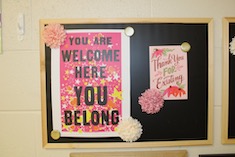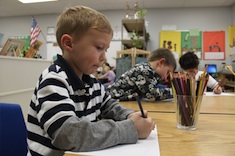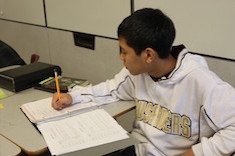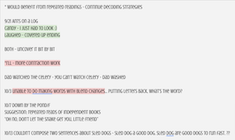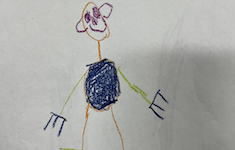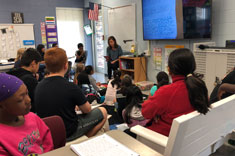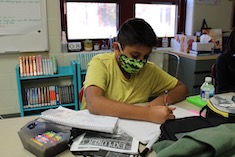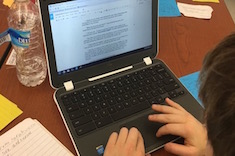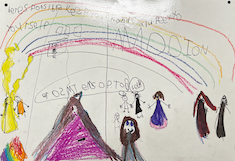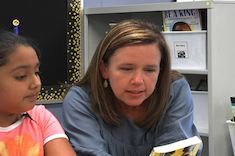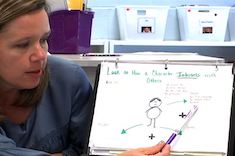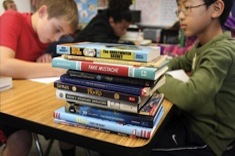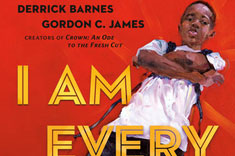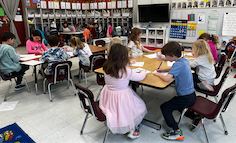Articles
Here is where you’ll find all the latest print features from our contributors. If you’d like to browse specifically by grade level, topic, or contributor, you can use the links in the right sidebar.
Latest Content
Sparking Curiosity: Developing Ownership of Learning Through “What If” Questions
Jodie Bailey encourages us to use “What if” questions in all content areas to give students the space to use their innate curiosity to engage in meaningful learning.
Detours: A Reminder of the Humanity of Students
Gretchen Schroeder reminds us of the importance of checking in with students and gauging how they are feeling—and then responding with authenticity and joy.
Increasing Student Choice
We want students to be lifelong learners, eager to grow, and equipped to face challenges. For this to happen, we have to let the classroom be a place that reflects these qualities. Julie Cox offers three innovative ways to leave choice in the hands of students. In turn, they learn to trust themselves and their learning, and believe that they are capable of finding answers.
Minilessons and Writing Instruction
Katie Linder reminds us of the importance of writing lessons to be predictable, efficient, and student-centered.
Plagued by Plagiarism
Plagiarism is an age-old issue, but with the emergence of AI tools, it’s plaguing our classrooms again. Vivian Chen offers three practical (and essential) approaches when working with writers.
Dealing with Overwhelm
Julie Cox offers three actionable ideas to fight frustration and take small steps to beat overwhelm.
Three Archetypes as Advocates for the Science of Reading
Matt Renwick defines three archetypes of personalities he has observed who have incomplete understandings about the science of reading. Matt offers approaches to each person, and notes that no one person neatly fits into a simple archetype.
Creating a Teacher Notetaking System
Dana Murphy, a reading specialist, guides all teachers in ways to develop a notetaking system that works perfectly because it is personalized.
Anchor Charts: A Tool for Every Classroom
Leigh Anne Eck reflects on the importance of anchor charts and the way they help students be more independent.
Using Self-Portraits as an Assessment Tool for Early Writers
Becca Burk guides us in using self-portraits as an assessment tool for early writers. Becca shares a rubric, self-portrait samples, and practical next steps for her kindergarten writers.
Fostering Math Identities with Picture Books
Mandy Robek uses picture books to help her students build their identities as mathematicians. Mandy shares the process and a booklist.
Developing and Listening to Your Inner Voice During Minilessons
Katie Linder reminds us of the importance of listening to (or ignoring) our own inner voices when delivering whole-group instruction. Katie guides us in using our inner voices to make in-the-moment decisions that sharpen lessons.
The Art of Noticing: Have Your Students Played with Language Today?
Stella Villalba noticed her students were so busy writing quickly, they were not paying attention to crafting language. A student, Gabriela, turns to a book and asks for help to make her writing sound like the book. Stella uses this moment to slow down the class and create space to be inspired to write in beautiful ways.
Author Moves: More Than “Lots of Detail”
Julie Cox deconstructs craft moves—literally and figuratively—with her high school writers. If you are looking to move conversations about craft beyond “The author used a lot of good details,” then you’ll want to try Julie’s suggestions.
Considerations for AI in the Classroom
Gretchen Schroeder considers the positive ways AI will influence her high school English classroom.
Leveraging AI in Elementary Literacy
David Pittman offers practical and time-saving tips for using AI to help make instructional plans. Need a rubric or discussion questions? David shows how using AI offers a springboard for creating tools for elementary literacy instruction.
Writing Will Help
Becca Burk’s kindergartners had a tough recess. As they were discussing what they could do differently, one student proclaimed, “Mrs. Burk, writing, writing will help!” Becca shares what unfolded as students made a plan and created signage to post around the playground as reminders for self-control.
Partnering Phonics and Poetry
Jen Court gets creative with using materials for more than one skill to layer in additional phonics instruction and practice. Jen provides a guide to think critically about reusing resources throughout the day and across content areas. Download the Planning Tool for Phonics Lessons.
My Teaching Toolbox (Part 2)
Dana Murphy reminds us that having a teaching toolbox makes planning efficient and effective. In this second installment of a two-part series, Dana offers two additional approaches to delivering strong reading instruction.
Small Shifts That Make a Big Difference
Dana Murphy names two practices that made a big difference in her work as a reading specialist. You may be surprised at the simplicity and smallness that led to powerful gains in her readers.
My Teaching Toolbox (Part 1)
Every now and then we make the classic teaching mistake: assign rather than teach. Dana Murphy curated her favorite teaching tools that help her stay inspired to continually teach students. This is part one of a two-part series.
Does Gender Impact Reader Engagement?
Gretchen Schroeder questions whether the protagonist’s gender influences her students’ engagement with a text. Using the dystopian novel Legend, which has two protagonists of different genders, Gretchen gathered feedback from her students. What she discovered was that a reader’s engagement with a text has more to do with empathy than with gender. You’ll love Gretchen’s new way of selecting whole-class texts for her students.
Holding Space for Counter-Narratives That Honor Communities
Stella Villalba guides us to expand the counter-narrative texts we use in our classrooms. Counter-narrative texts challenge the stereotypes often seen about a group of people, and they celebrate the joy and resilience of a community. Stella provides a list of critical questions that allow us to deeply explore texts, as well as suggestions of books to read.
Considering Positionality and Developing New Sight Lines
Gretchen Schroeder shares a powerful approach to reading response to help students consider their positionality in a scene. Your identity, your thoughts, and your experiences influence the way that you relate to a text. This is your positionality as a reader, and it’s important to consider your positionality within a text because it explains how and why we come to certain conclusions as we read.
Partnering with Families on Reading
Tara Barnett and Kate Mills share ways to make families partners in the pursuit of creating lifelong readers. They share research that makes a case for “just” reading and compelling suggestions for families to support their children’s reading lives.
Let’s Write Together: The Importance of Class Books
Jen Court considers whether creating class books is a valuable use of time for today’s young students. As she teases out this question, she realizes class books are a relevant and essential instructional strategy.
How Long Does This Have to Be?
Students often question how long a piece of writing needs to be. Gretchen Schroeder shares a strategy that changed the focus of writing projects from length to meaning.
Everyone Wants to Write?
Becca Burk reflects on creating a classroom where everyone wants to write. She offers timely advice for creating a community of writers.
Putting Together the Pieces of a Classroom (Classroom Organization)
When Julie Cox moves into a smaller classroom, she realizes that to make it a room where students learn and thrive, she needs to shift her mindset. Rather than simply putting things where they fit, she asks three questions to make intentional decisions that will support learning.
From a Blank Canvas to a Community Space
Jodie Bailey approaches setting up her math classroom as a blank space with an invitation for students to engage in establishing identity, creativity, and collaboration.
Browse Content By
Type
Category
- Assessment Tools
- Big Fresh Archives
- Booklists
- Choice Numeracy
- Classroom Design
- Common Core
- Community Building
- Conferring
- Content Literacy
- Digital Literacy
- English Language Learners
- Equity
- Family Relations
- Free Samples
- Guiding Groups
- Leadership
- Literacy Coaches
- Mentor Texts
- Minilessons
- New Teacher Mentors
- Podcasts
- Poetry
- Quote Collections
- Reading Strategies
- Self Care
- Struggling and Striving Learners
- Talking and Listening
- Teacher Study Groups
- Teaching Reading
- Teaching Writing
- Word Study and Vocabulary
Author
- Melissa Quimby
- Nawal Qarooni
- Gwen Blumberg
- Julie Cox
- The Lead Learners
- Hannah Tills
- Josie Stewart
- Ruth Metcalfe
- Mallory Messenger
- Becca Burk
- Jodie Bailey
- Vivian Chen
- Mary Brower
- Tiffany Abbott Fuller
- Stephanie Affinito
- Ruth Ayres
- Leigh Anne Eck
- Heather Fisher
- Shari Frost
- Julie Johnson
- Suzy Kaback
- Gigi McAllister
- Shirl McPhillips
- Melanie Meehan
- Cathy Mere
- Debbie Miller
- Tara Barnett and Kate Mills
- Tammy Mulligan
- Dana Murphy
- Bitsy Parks
- David Pittman
- Brenda Power
- Heather Rader
- Matt Renwick
- Mandy Robek
- Christy Rush-Levine
- Gretchen Schroeder
- Jen Schwanke
- Brian Sepe
- Katherine Sokolowski
- Stella Villalba
- Jennifer Vincent
Grade Level
Choice Literacy Membership
Articles
Get full access to all Choice Literacy article content
Videos
Get full access to all Choice Literacy video content
Courses
Access Choice Literacy course curriculum and training



